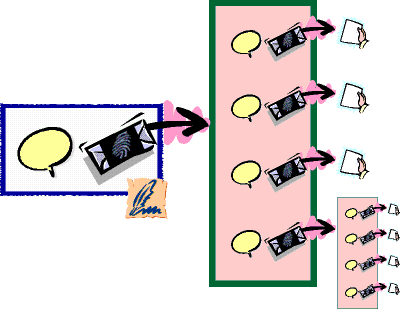Editor's Note: This document represents the general DSig architecture as envisioned by the DSig Design team. Work in implementing this architecture along with interaction with other groups working on metadata related efforts (PICS-NG, XML, DSig Collections, etc. ) has led to substantial changes in the way we now envision the DSig architecture. The document presented below is incongruous with the current DSig 1.0 Digital Signature specification and the planned direction for DSig 2.0 and thus is obsolete. A major revision of the DSig Architecture will be available by 1 December, 1997 at http://www.w3.org/pub/WWW/TR/WD-DSIG-label-arch.html.
This is a W3C Working Draft for review by W3C members and other interested parties. It is a draft document and may be updated, replaced or obsoleted by other documents at any time. It is inappropriate to use W3C Working Drafts as reference material or to cite them as other than "work in progress". A list of current W3C working drafts can be found at: http://www.w3.org/pub/WWW/TR.
Note: since working drafts are subject to frequent change, you are advised to reference the above URL, rather than the URLs for working drafts themselves.
This document presents the architecture and design rationale behind DSig's Digital Signature Label specifications. The overall goal is to use digitally signed labels to make authenticatable assertions about standalone documents or about manifests of aggregate objects. The three basic elements, digital signatures, assertions, and manifests, are each analyzed in terms of its design, operation, data format, and distribution strategy. These elements can be assembled today within a PICS label to make a signed assertion about an information resource, or by signing a manifest, making assertions about several resources.
The Digital Signature Label team is chartered with the design of a signed assertion format which states 'the keyholder believes assertion(s) about information resource(s).' This statement format satisfies the twin goals of the DSig project: to identify and endorse information resources. This team, in turn, has decomposed its goal into three subtasks:
Each of these subtasks will result in interlocking technical specifications:
(Please consult the DSig Team pages for detailed updates on the timeline and status of these specifications.)
Each of these components can be combined in several ways; this document provides context on how they fit together:
For example, a typical DSig scenario combines the three components in a tree. Here is how an author might first package up an applet in a manifest declaring his ownership, then additional certify that the package, taken as a whole, is a safe and useful applet when used correctly.
The recipient can reverse the process, verifying the author's signature and constructing a pathway of three hash values and two assertions between the label and the eventual applet data proving the author's own identity and endorsement of that applet. DSig's real power, though, is that a third party can come along and replace steps 3 and 4 above:
In this scenario, the end-user's trust manager can go seek out a reviewer's endorsement and make a similar induction chain from the reviewer to the "cool" applet. With DSig in place, the end-user's trust policy can automate the decision process.
As part of its deliberations, the SigLabel team crafted a mission statement to define its design envelope.
A Digital Signature Label is a standalone, cryptographically-protected statement that 'keyholder believes assertion about information resource(s)'.
Expanding some of the key terms defines the scope of our effort:
In this document, we illustrate several of the concepts referred to above with the following icons:

Key Information |
 Information Resource |
 Identity Certificate |
 Resource Reference Information |
 Ciphersuite |
 Assertion |
 Digital Signature |
 Signature Label |

Signature Block |
 Manifest |
This section describes the design, operation, format, and transmission of the DSig signature block. Our SigBlock is a general-purpose, simply encoded, cryptographically-neutral standalone signature -- and it does not rely on any particular certification/identification scheme, either. It does not have any inherent semantics: the SigBlock only establishes that the some process had access to the data and a secret (we will argue later that its semantics are strengthened when it is embedded in a particular application).
The SigBlock was identified as a separate design task very early on in the project. Signature systems such as PKCS-7', PGP, etc. traditionally build upon a core data structure which represents the actual cryptography, and DSig is no exception. On the other hand, every signature system goes on to add idiosyncratic information to this structure: crytographic protection (padding, protection of algorithm identifiers), certification-authority dependence (naming, key serial #s), content-dependent modification (how is whitespace hashed in?), and mini-assertions (time of signature, whether signed in hardware/software). The result is then encoded in a particular format (ASN.1, ASCII armor) and often used to wrap the whole signed data stream. The design goals for the DSig SigBlock differentiate it from such approaches:
To understand the SigBlock design, consider this picture of the signing process:

[Diagram of document being signed by a ciphersuite and a key to produce a bright, shiny digital signature.]

[Diagram of the SigBlock itself with its pile of keyholder information, certificates and digital signature cryptography bits.]
There are three central pieces of data in the diagrams above:
With these concepts in mind, here's the story:
A user controls her own signing key and certificate. Her software and hardware tokens implements a few ciphersuites. With a document and choice of ciphersuite in hand, the signature process runs through to completion and produce a bright, shiny chunk of signature-crypto. Along the way, the signing key, date, and hash function name may have all been inputs to the signing process and show up inside the signature-crypto. To make a complete, formatted SigBlock, though, a few more pieces of information have to be pieced together as discussed in Section 3.3.
There are a few more operations available to our user. She can proceed to attach additional parallel signatures of the same document. She may do this herself using several different algorithms so her recipients in other jurisdictions or in the future can verify her signatures against whichever ciphersuites they (still) trust. Other like-minded colleagues can also attach their signatures to the same statement to support policies that require K-of-N signatories to agree. She can't cascade another signature to her own, though. The DSIG design team has decided to support SigBlocks with parallel signatures, but not cascaded statements about a signature. Successive endorsements are still possible, though, by giving a SigLabel a name a producing another SigLabel about the first (See Section 4.4).
The SigBlock Format is a concrete representation of the various data elements required for a standalone signature. Broadly speaking, there are two levels at which we discuss the SigBlock format: the generic arrangement of attribution-information and signature data, and the specific level of encoding choices for particular ciphersuites.
[@@ diagram of SigBlock data structure with examples of http://w3.org/dsig/rsa/md5 and http://rsalabs.com/PKCS-7/ --a structured set of bits vs. an opaque ASN.1 blob]
At the generic level, a SigBlock needs to flesh out the signature-crypto with information about the signer. The first step is to pair the signature with attribution-info, a passive container for certificates and other credentials. This allows the trust management system to evaluate whether a certain keyholder is trusted and whether the key is valid. The second step is to make a link from the signature to the keyholder, by adding some keyholder-info to the signature itself.
There are several kinds of keyholder-info envisioned by DSig: the key itself, a digested fingerprint of the key, a Distinguished Name, a certifying authority and serial number, a role, etc. Each type serves to establish a path from the key to a credential (keyholder). Remember, the whole attribution-info section is optional material; the keyholder-info is the only normative link from a signature to a certification system. It's a critical disintermediating step, because it allows the user to separately choose a CA infrastructure without changing the signature block format.
That's it for the generic level. By treating the cryptography as opaque, the only additional information required is keyholder identification. Within the cryptographic details, though, are a great number of critical, specific formatting decisions.
The ciphersuite is what defines the information found below it. For an existing format, say PKCS-7' (for RSA), all that's possible is to say "coming up, one blob of PKCS-7' data". DSig's preferred modes, though, encourage more trasnparency. The DSig ciphersuite for RSA, for example, is inspired by SDSI, with separate entries for the exponent, ciphertext, hash algorithm, signature time, etc burst out into an S-expression.
Note well the location of the signature-timestamp: per the first goal listed in Section 3.1, the only cryptographically protected data is found within the customizable signature-crypto. If an implementation of RSA needs to sign its hash algorithm id, it can do so on its own -- rather than predicating that all DSig-usable ciphersuites must. For example, the US Government's Digital Signature Algorithm need not, since it is only defined in conjunction with SHA.
Of course, all this flexibility empowers any organization to issue a new ciphersuite -- how can users trust that they are cryptographically safe combinations? Indeed, how will the DSig project validate its own recommendations? In the end, users and organizations will have to choose what makes sense for themselves. DSig will produce a small set of the most popular ciphersuites and work closely with leading cryptographers and organizations to vet its work. In particular, the Signature Label Implementation Team will include a user-driven review team that will cooperate with RSA Labs (holder of the PKCS specifications), the IETF, and IEEE 1363 in establishing its core set of DSig ciphersuites.
It is worth reiterating that the SigBlock is only a stepping-stone in our work. It is not deployable on its own for two reasons: 1) technologically, because it does not have any pointer or connection to the data being signed -- not even a document hash (since some signature ciphersuites do not expose an intermediate hash value) and 2) philosophically, because it does not include any assertions about the data being signed. Deploying 'naked' SigBlocks without associated assertions drags us back to circular question "yes, but what does this signature mean?". In short, the DSig project only supports signed assertions, which translates into SigBlocks embedded in PICS labels or in a manifest. SigBlocks may later be embedded in other formats, which is why we have made the effort to separate out its definition -- but even then, not without clear, automatable semantics in the new embedding.
The first implementation target is an embedding of SigBlocks into PICS 1.x labels, as discussed in Section 4.4. In this case, signing PICS ratings imbues SigBlocks with stronger semantics particular to this context: 'keyholder believes ratings are correct'.
While many signature projects have succeeded at proving the identity or provenance of an information resource, the DSig project breaks new ground because of its emphasis on endorsement, in the form of signed assertions which users can rely upon to make trust decisions automatable. The bedrock of this work is reducing generic "assertions" to concrete rating labels so we can have clear, machine-readable semantics to sign. In this section, we discuss the design of a assertion format, inspired largely by PICS-1.x.
Though there are several reasons motivating out adoption of PICS -- its distribution mechanisms, established user base, rating organizations -- but this section only discusses the rating part of a label; ensuring the integrity of the binding to the eventual information resource is a critical function presented in Section 5.
DSig needs an assertion system designed to convey a clear meaning applied to almost any kind of content. This drives two sets of design criteria, one about the semantics of 'assertable' statements and another about what can be labeled.
DSig needs to apply assertions with those qualities to several different kinds of documents:
Finally, there is a new consideration about the heritability of signed assertions. While it is technically correct to insist that ratings only apply to the particular information resource specified, typical Web client usage may trigger a whole series of actions when visiting a single 'location': loading inline images, embedded applets, etc. So at one level, assertions need to precisely delineate what they apply to. Secondly, there is a mathematical question of how far to extend a network of linked objects. A SigBlock protects a label directly; the label points indirectly to a manifest; the manifest points indirectly to the target information resource; and so on. Even if each step of the way is verified by a document hash, how large can the tree grow with confidence that all of the links allow the top-level assertion to be inherited? DSig design guidelines are clear on this point as well. The conservative rule is that assertions only apply one level removed by default.
There are a number of additional considerations about working with collections of different resources, which are discussed at length in Section 5.

[Diagram: An signature label which combines an assertion, information about the referenced resource, and a digital signature block. If we zoomed in on the SigLabel, a PICS 1.x label, it would contain a pointer-to-schema (URL), pointer-to-document (URI), machine-readable rating, extended non-machine-readable rating comments, info-about-rating (on, by, generic flag), info-about-document (resinfo), and embedded SigBlock.]
A rating assertion is a passive data structure which can be used to answer a series of questions, whether in the context of a simple content-filtering UI or a full-blown trust management system:
Of course, an assertion label alone cannot prove that a recipient should believe that assertion. A Trust Management systems has to investigate several aspects of a signed label before making that decision. For example, the TM would have to establish the integrity of the connection of the label to the resource it's labeling. Particular pieces of resource information can be attacked, but taken together they can prove the integrity of the association between assertion and the resource. For example, providing the name alone is vulnerable to attacks on the Domain Name System; a cryptographic hash could be reverse-engineered or 'birthday-attacked'; and a file length can be tampered with, but a TM system can check each of these.
All of this additional information, or resinfo, has its roots in PICS-1.1 usage, but expands the range of possible additional data and provides for its own extension mechanism. More details can be found in the specification for signing PICS 1.x labels by Brian LaMacchia. Paul Resnick, one of the original designers of PICS, commented that:
I admit that the PICS-1.1 label format does not syntactically separate the components that describe the information resource (e.g., the URL, hash, and ratings) from those components that describe the label (e.g., expiration date, signature, by). The PICS designers' understanding of this separation idea evolved as we wrote the specs: in our text description of the fields in the spec, we divide them into those that describe the document and those that describe the label, but we didn't get so far as to make a syntactic distinction, in the labels themselves. It remains to be seen whether we can remedy this in PICS-1.2 or 2.0, but it is certainly an important design goal.
We are proposing using the PICS rating label format with some expected modifications. Some are minor, like allowing full S-expressions as the value of an extension field (instead of only allowing strings). Others are more substantial, but already in discussion for PICS-1.2, such as string-valued ratings. As DSig implementation continues, we expect a dialogue with the PICS Working Group which will influence the evolution of both projects.
With respect to signing PICS rating labels, there is a concern about which PICS extension fields are included under the protection of the SigBlock. For now, we propose that the entire PICS label and all extension data must be signed together without exceptions.
Finally, it makes sense to provide default rating systems for basic signature applications, along the lines of 'This is True' and 'This is Mine'. Just as the SigBlock is used to prove the identity and integrity of an assertion, these rating systems can be used to make signed testaments of the provenance and veracity of information resources themselves.
One of the primary reasons DSig builds upon PICS for its label syntax is to reuse PICS's three label distribution mechanisms. Since SigLabels are just PICS labels with embedded SigBlocks, they can be sent:
The first mode could be popular for many other trust management applications, such as embedding SigLabels into applets, fonts, and other protected resources. Especially for the latter two modes, though, there must be a reliable link to the actual information resource. As discussed in Section 4.2, labels must accommodate a range of additional resource information to vouch for the connection. Document hashes are a particularly effective way of proving the link even when the label and content are separated, but only for static documents. For dynamic data, such as a chat room or live video camera feed, other properties might be used.
Note that this assertion distribution strategy also fixes a SigBlock distribution strategy: embedded in rating labels. SigBlocks are only found embedded in PICS labels in this scenario. This makes the association of a SigBlock to its signed data extremely clear.
Finally, there is another implicit resource that must be distributed reliably with the assertions: the rating schema. Since a rating systems can legitimately exist in several languages and compatible versions, it is not a simple task to protect the integrity of the reference to the rating system. DSig recommends that applications which are sensitive to this need should use manifests and include the exact rating system(s). In this case, a rating system is just one more information resource the overall package depends on, like a font or a configuration file.
Many applications which call for the added security and integrity of digital signatures actually address sets of interrelated content rather than a single information resource. Several of the organizations participating in the DSig design phase arrived with proposals including proprietary manifest formats. This section presents common design considerations for using standalone manifest files and proposes a new intermediate, the DSig Common Manifest Format (DCMF).
The critical difference between a set of singular signed assertions and as collected into a manifest and signed jointly is the interrelationships between the elements. Manifests establish relationships by the mere act of selection and grouping; by rating components on the same scales; and through additional resource information. Each entry in the manifest also needs to provide enough information about the target resource to unambiguously identify it. Finally, there can be additional goals for particular manifest formats, such as optimized data layout, real-time manifest generation, and user interface support.
The relationships between components can dramatically shade their meaning. A picture and a caption, for example, are strongly connected, and a different choice among alternative captions can shade the meaning of the picture dramatically. First, the act of preparing a manifest alone allows us to make statements about the aggregate as a whole. Different manifests can associate a picture with different captions. In a legal context, it can be essential to demonstrate that all parties are referring to the complete agreement (e.g. a Will and its codicils). Second, the assertions about each entry in the manifest establish another kind of relationship, specific to the rating system at hand. A user could select components by label ('please show all the Impressionist pictures'). Third, additional resource information can clarify relationships like '32-bit-color-version-of' or 'full-screen-sized'.
Beyond clarifying the semantics of a package, a manifest file must unambiguously identify its components to legitimately stand in for signing each individual part. Operationally, manifests allow us to seal N resources at once, which is more efficient than having to execute N potentially expensive and time-consuming signature operations. To mathematically verify this aggregation, each referent must include verifiable information about the target resource, like its hash fingerprints. In fact, the entire resinfo mechanism presented in Section 4.2 actually emerged from manifest discussions. The PICS-1.1 resinfo extension was created to emphasize the isomorphism between an individual label and an individual manifest referent.
Finally, there can be more specific design goals for particular manifest formats. Some applications may integrate the 'user interface' of a package with the manifest itself. An HTML WebMap file can represent manifest referents and a visual hierarchy, multimedia descriptions, and more. Another example is signing streaming or dynamic data. For a real-time video stream, it may be essential to provide a new kind of hash tree for each video segment rather than a single hash value at the end. A dynamically generated web page may have several components and use a manifest that sends its table-of-contents first, then its hash values. Such data layout considerations are discussed in Section 5.3 and in the DCMF specification.

[Diagram: a SigLabel pointing at an aggregate-object-manifest instead of a single document (and the target resources, in turn, which can also be manifests).]
As far as the signature label is concerned, a manifest is just another type of information resource. In turn, the manifest is just the collection of resource references; the cryptographic protection is inherited from the SigLabel and doesn't appear directly within the manifest. The induction chain from the SigBlock to the target resource is mediated by two assertions, one from the SigLabel that applies to the entire manifest and an optional assertion from the referent in the manifest.
The manifest itself provides several pieces of data for each referent: name, hash information, additional resource information, and a rating assertion. This is the same information provided for a reference in a singular PICS SigLabel, too. The hash information, in particular, is the crux of the chaining argument that allows the top-level SigBlock to 'sign' the target data. In fact, the chain can extend further if the target is another aggregate subcomponent represented by a manifest.
There is a new operational concern about signing several assertions jointly. To protect the cryptographic hygiene of a signing key, it may be necessary to restrict which kinds of assertions it can speak for. For example, it could be risky to use the same key to protect high-value assertions about indemification and low-value assertions about the color scheme.
The data format for the manifest should be compact and allow efficient access to data about each referent. In DCMF, 'fixed' information like the selection of hash algorithms used and the rating schemas are declared once, in a preamble. Then, for each referent several columns of data are available: the name (URI), ratings, several hash values (if applicable), and additional resinfo.
This abstract model of a manifest describes many formats: Java JARchives, IBM's Cryptolope, a PICS labellist, an HTML Web collection (Sitemap). Though a file in any of these formats could be signed with a SigLabel, and a Trust Management engine could parse all of them to establish links back to the target resources, DCMF's alleviates compatiblity problems. DCMF's data layout is designed to be compact, streamable, easily decoded, extensible, and scalable -- an evolutionary successor to many of these contenders.
Since manifests are useful indexes quite separately from SigLabels, several distribution strategies should be supported. Standalone manifest files can be made available with the data, from third parties, or embedded directly into a package (e.g. a ZIP or TAR archive). The complexity is compounded by the additional options for distributing SigLabels. The SigLabel providing the integrity of a manifest might be embedded within it, sent with it over HTTP, or come from yet another third party.
As long as a manifest file is static (i.e. can be hashed itself) and can provide verifiable information about which resources it refers to, any of these distribution strategies will work. The mathematics can support an induction chain from any SigLabel through any manifest to any target resource -- even through a cascaded chain of nested manifests.
Though we have separated the tasks into understanding how each of these three pieces work on their own, they are intended to work together. This section explains how the DSig project implementation will assemble these components to solve users' trust problems.
In general, the user starts with a single object or aggregate object to make an assertion about. The assertion is prepared as a PICS 1.x rating about the object or aggregate, then the label is signed with a SigBlock. Indeed, several signatures can be included in parallel, from multiple endorsers using multiple ciphersuites. In the case of an aggregate object, the components are listed out in a manifest, optionally including assertions describing the role of each.
There are many combinations of distributions strategies to reach the end user. A simple on-line scenario is a signed press release with a SigLabel in its HTTP entity headers. For an aggregate object distributed over the Web, a user could fetch the manifest over HTTP and receive the author's SigLabel with it before proceeding to fetch any of its components. A CD-ROM might include a manifest with an embedded SigLabel. Before running an applet found on the Internet, a user's trust engine could try to fetch a SigLabel from a third-party label bureau. Scenarios can be generated for every combination of information resource, speaker, format, and distribution technique.
Digital signature labels are assembled from three interlocking components. Signature blocks, assertions, and manifests have each been described in terms of their design, operation, format, and distribution. The initial deployment target is signed PICS rating labels applied to single information resources; manifests are a particular kind of information resource which can be used to point in turn at several more resources while maintaining cryptographic integrity of the signature label.
This architecture document serves as the context for several subsidiary technical documents specifying the exact syntax and semantics of the SigBlock, SigBlock embedding in PICS 1.x, and DSig Common Manifest Format (DCMF). Comments on this document should be directed to the author or any of the specification editors. The SigLabel design team has its own (closed) mailing list for discussing these issues at w3c-dsig-label@w3.org; W3C member organizations can send comments there directly. Members are also encouraged to join the DSig implementation phase to continue developing these specifications in products, or through our user-organization review teams.
This document reflects a hard-won consensus among all the various players of the SigLabel team. Many of the ideas here came from different participants; my role is primarily to wrap it all together here in this architecture document. Kudos to all!
Copyright © 1997 W3C (MIT, INRIA, Keio ), All Rights Reserved. W3C liability, trademark, document use and software licensing rules apply.